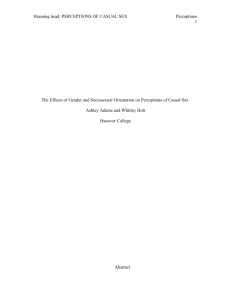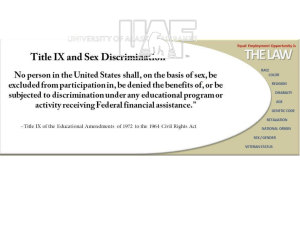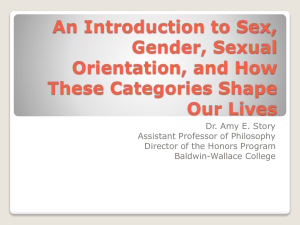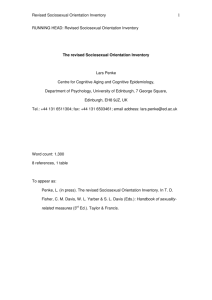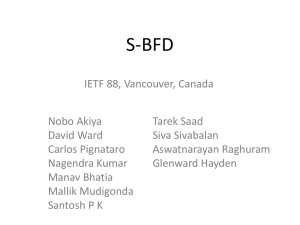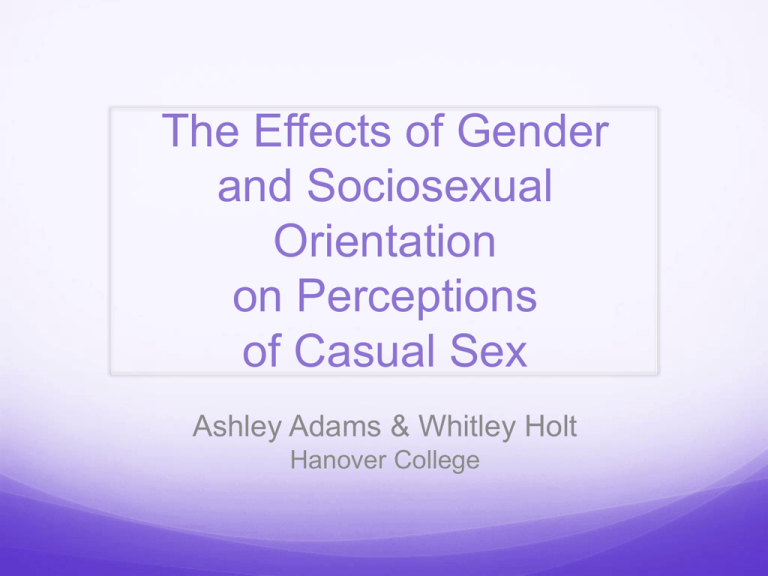
The Effects of Gender
and Sociosexual
Orientation
on Perceptions
of Casual Sex
Ashley Adams & Whitley Holt
Hanover College
Casual Sex
Casual sex is defined as a sexual encounter that may
or may not involve intercourse between two people
without the expectation of developing a relationship
(Paul et al., 2000)
Rates of casual sex are thought to be increasing
among both males and females, but the increase
seems to be especially strong among females (Oliver &
Hyde, 1993)
Double Standard
Women are permitted to engage in sexual relations only
within a committed love relationship, whereas men are
permitted to have as many sexual partners as they want
without condition
(Milhausen & Herold, 1999)
Sex is encouraged for males, and discouraged for
females
al., 2007; O’Sullivan & Byers, 1992)
(Levesque, et
Mixed Evidence
Despite an increase in permissiveness in sexual
attitudes and behaviors among women, the sexual
double standard continues to thrive
(Leigh,
Aramburu, & Norris, 1992; Oliver & Hyde, 1993; Paul &
Hayes, 2002)
Other research suggests that the double standard has
diminished due to an increase in female liberation
(Fraley, 2005; Sprecher, et al., 1987; Levesque, et al., 2007)
Past Research
Main focus on perceptions of the initiators of casual sex
Other important factors:
Gender of the participant
Sexual attitudes and behaviors of the participant
Gender of the Participant
Gender differences in receptivity to sexual offers (Clark
& Hatfield, 1989)
Participants were university students questioned by male
and female confederates
“Would you go to bed with me?”
Majority of men agreed to the sexual encounter, while all
women refused
Concluded men are much more likely to engage in casual
sex than females
Suggests that males may judge casual sex less harshly than
females
Sociosexual Orientation
Refers to one’s tendency to prefer sexual engagement
with or without commitment
One explanation for the decline in the double standard
could stem from the shift of sociosexual orientations
From restricted to unrestricted
Women are more likely to engage in casual sex than
they have been in the past
Research Question
What are the factors that influence how one evaluates
individuals who initiate casual sex?
Gender of the initiator of the sexual act
Gender of the participant
Sociosexual orientation of the participant
Method
Participants
262 Participants
Age range: 18-24 years old
18-19: 42%
20-21: 28%
22-24: 30%
Female: 68%
Heterosexual orientation: 85%
Currently attending college: 79%
Currently in a relationship: 50%
Method
Procedure
Online Survey
Informed Consent
After consenting, participants were randomly assigned to two
conditions
Scenarios
In each condition, participants were asked to read three
scenarios, each describing a situation in which an individual
initiated casual sex
The gender of the initiator was manipulated
Revised Sociosexual Orientation Inventory
Demographics
Debriefing
Scenario Example
“Matt and Jane were both students at a university. They had
seen each other around campus, and became acquainted
when they enrolled in the same class. Matt asked Jane if
she would like to hang out and study for the upcoming
exam. Jane suggested that they could go to her apartment
since she lived alone. That night Matt arrived at Jane’s
apartment and they began studying. After an hour they
decided to take a break. Jane put her hand on Matt’s thigh
and offered to give him a back rub. Then she leaned over to
Matt and began to passionately kiss him. They began to
remove their clothing and had sexual intercourse” (Kowalski
- Revised, 1992).
Method
Evaluation of Initiator
After each scenario, participants were asked four
questions in which they evaluated the initiator of the
sexual encounter
Example: “How positively do you perceive Jane?”
Evaluations were made on 5-point Likert scales
Combined all scenarios α=.91
Since the participants responded similarly to the
questions and scenarios we were able to average their
answers
Method
Revised Sociosexual Orientation Inventory
“Assesses one’s willingness to engage in uncommitted
sexual relations” (Penke, 2011)
Uses a 5-point Likert Scale
All 9-items α= .87
SOI-R example questions
“How many different partners have you had sex with in the
past 12 months?”
“With how many different partners have you had sexual
intercourse without having an interest in a long-term
committed relationship with this person?”
Data Analysis
Between-subjects design
3-way ANOVA
Factors:
Gender of the scenario initiator (male, female)
Gender of the participant (male, female)
SOI-R category placement (unrestricted, restricted)
Results
No significant effect for gender of initiator
Significant main effect for gender of the participant
Significant main effect for SOI-R
No significant interactions
Gender of Initiator
3
2.8
Positive Evaluation of Initiator
2.7
2.5
2
1.5
1
Female
Male
Gender of the Initiator
F (1, 252) = 2.072, p = 0.151
Gender of Participant
3
2.9
Positive Evaluation of Initiator
2.6
2.5
2
1.5
1
Female
Male
Gender of the Participant
F (1, 252) = 13.75, p < 0.001
Participant SOI-R Score
3.5
Positive Evaluation of Initiator
3.1
3
2.5
2.4
2
1.5
1
Restricted
Unrestricted
SOI-R Score
F (1, 252) = 52.11, p < 0.001
Conclusion
No double standard was found
Male initiators were not judged more positively than
female initiators
Male participants evaluated the initiators more
positively than women
This was consistent with the results from Clark &
Hatfield’s study, that men have a more positive view on
casual sex
People who have more positive attitudes towards
casual sex viewed the initiators more positively
Limitations
Age range of sample
Use of hypothetical scenarios
Future Directions
Would perceptions be different if the initiators’ past
sexual behavior was stated at the beginning of the
scenario?
Milhausen & Herold (1999)
Studied the attitudes and sexual behaviors of university
women
“The number of partners a woman has had is a strong
predictor of their acceptance of men with many partners”
Questions



